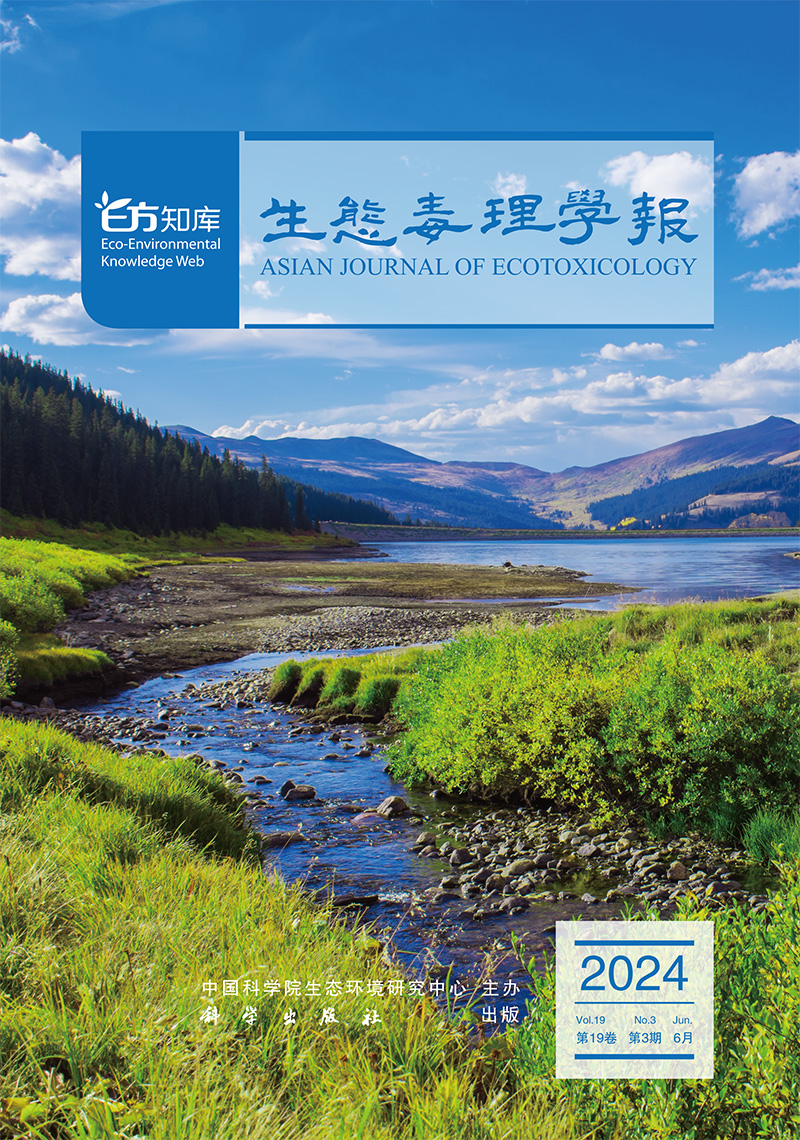|
刘亚楠, 陈晓倩, 刘敏, 等. 防污漆活性物质敌草隆对两代摇蚊的生命周期毒性[J]. 生态毒理学报, 2017, 12(1):193-200
Liu Y N, Chen X Q, Liu M, et al. Life-cycle toxicity of two generation Chironomus kiiensis induced by diuron used in antifouling paints[J]. Asian Journal of Ecotoxicology, 2017, 12(1):193-200(in Chinese)
Google Scholar
Pub Med
|
|
梁艺怀, 刘敏, 邓芸芸, 等. 船舶防污漆杀生活性物质敌草隆的上海港区环境风险评价[C]. 北京:中国毒理学会第四届中青年学者科技论坛, 2014
Google Scholar
Pub Med
|
|
梅承芳, 陈进林, 田亚静, 等. 防污漆中活性物质海洋环境风险评估关键技术探讨[J]. 生态毒理学报, 2015, 10(1):66-80
Mei C F, Chen J L, Tian Y J, et al. Review on recent approaches for marine environmental risk assessment of active substances in antifouling paints[J]. Asian Journal of Ecotoxicology, 2015, 10(1):66-80(in Chinese)
Google Scholar
Pub Med
|
|
Nebeker A V, Schuytema G S. Chronic effects of the herbicide diuron on freshwater cladocerans, amphipods, midges, minnows, worms and snails[J]. Archives of Environmental Contamination and Toxicology, 1998, 35:441-446
Google Scholar
Pub Med
|
|
Mansano A S, Moreira R A, Dornfeld H C, et al. Effects of diuron and carbofuran and their mixtures on the microalgae Raphidocelis subcapitata[J]. Ecotoxicology and Environmental Safety, 2017, 142:312-321
Google Scholar
Pub Med
|
|
Masojídek J, Souček P, Máchová J, et al. Detection of photosynthetic herbicides:Algal growth inhibition test vs. electrochemical photosystem Ⅱ biosensor[J]. Ecotoxicology and Environmental Safety, 2011, 74:117-122
Google Scholar
Pub Med
|
|
Organisation for Economic Cooperation and Development (OECD). OECD Guidelines for the Testing of Chemicals, 211 Daphnia magna Reproduction Test[S]. Paris:OECD, 2012
Google Scholar
Pub Med
|
|
中华人民共和国国家质量监督检验检疫总局. GB 30000.28-2013化学品分类和标签规范第28部分:对水生环境的危害[S]. 北京:中国标准出版社, 2013
Google Scholar
Pub Med
|
|
Wang J B, Shi T, Yang X L, et al. Environmental risk assessment on capsaicin used as active substance for antifouling system on ships[J]. Chemosphere, 2014, 104:85-90
Google Scholar
Pub Med
|
|
Qian P Y, Xu Y, Fusetani N, et al. Natural products as antifouling compounds:Recent progress and future perspectives[J]. Biofouling, 2009, 26(2):223-234
Google Scholar
Pub Med
|
|
Xu Q W, Barrios C A, Cutright T, et al. Evaluation of toxicity of capsaicin and zosteric acid and their potential application as antifoulants[J]. Environmental Toxicology, 2005, 20(5):467-474
Google Scholar
Pub Med
|
|
Angarano M B, McMahon R F, Hawkins D L, et al. Exploration of structure-antifouling relationships of capsaicin-like compounds that inhibit zebra mussel (Dreissena polymorpha) macrofouling[J]. Biofouling, 2007, 23(5):295-305
Google Scholar
Pub Med
|
|
Cope W G, Bartsch M R, Marking L L. Efficacy of candidate chemicals for preventing attachment of zebra mussels (Dreissena polymorpha)[J]. Environmental Toxicology and Chemistry, 1997, 16(9):1930-1934
Google Scholar
Pub Med
|
|
LaHann T R, DeKrey L J, Tarr B D. Capsaicin analgesia:Predictions based on physico-chemical properties[J]. Proceedings of the Western Pharmacology Society, 1989, 32:201-204
Google Scholar
Pub Med
|
|
Oliveira I B, Groh K J, Schönenberger R, et al. Toxicity of emerging antifouling biocides to non-target freshwater organisms from three trophic levels[J]. Aquatic Toxicology, 2017, 191:164-174
Google Scholar
Pub Med
|
|
陈进林, 梅承芳, 高亮, 等. 标准化测试中不同食物浓度对大型溞生长和繁殖的影响[J]. 生态科学, 2015, 34(6):42-47
Chen J L, Mei C F, Gao L, et al. Effect of food concentration on the growth and reproduction of Daphnia magna in a standard test[J]. Ecological Science, 2015, 34(6):42-47(in Chinese)
Google Scholar
Pub Med
|
|
中华人民共和国环境保护部. 中华人民共和国环境保护部令第7号新化学物质环境管理办法[S]. 北京:中华人民共和国环境保护部, 2010 Ministry of Environmental Protection of China. Measures for Environmental Management of New Chemical Substances[S]. Beijing:Ministry of Environmental Protection of China, 2010(in Chinese)
Google Scholar
Pub Med
|
|
中华人民共和国环境保护部化学品登记中心《化学品测试方法》编委会. 化学品测试方法生物系统效应卷[M]. 第2版. 北京:中国环境科学出版社, 2013:22-29, 94-112
Google Scholar
Pub Med
|
|
Organisation for Economic Cooperation and Development (OECD). OECD Guidelines for Testing of Chemicals, 202 Daphnia sp. Acute Immobilization Test[S]. Paris:OECD, 2004
Google Scholar
Pub Med
|
|
International Organization for Standardization (ISO). ISO 6341. Water Quality-Determination of the Inhibition of the Mobility of Daphnia magna Straus (Claera, Crustacea)[S]. Geneva:ISO, 2012
Google Scholar
Pub Med
|
|
Organisation for Economic Cooperation and Development (OECD). OECD Series on Testing and Assessment No.23(Second Edition). Guidance Document on Aqueous-phase Aquatic Toxicity Testing of Difficult Test Chemicals[S]. Paris:OECD, 2019
Google Scholar
Pub Med
|
|
蔡小宇, 姜锦林, 单正军, 等. 壬基酚聚氧乙烯醚对大型溞的急性和慢性毒性效应[J]. 生态与农村环境学报, 2018, 34(1):81-86
Cai X Y, Jiang J L, Shan Z J, et al. Acute and chronic toxicity of nonylphenol ethoxylates to Daphnia magna[J]. Journal of Ecology and Rural Environment, 2018, 34(1):81-86(in Chinese)
Google Scholar
Pub Med
|
|
李娜, 聂湘平, 黎华寿, 等. 多氯联苯(PCB153与PCB28)对大型溞的毒性效应研究[J]. 农业环境科学学报, 2012, 31(5):891-897
Li N, Nie X P, Li H S, et al. Toxicity effects of PCB153 and PCB28 on Daphnia magna[J]. Journal of Agro-Environment Science, 2012, 31(5):891-897(in Chinese)
Google Scholar
Pub Med
|
|
Mansano A S, Moreira R A, Dornfeld H C, et al. Acute and chronic toxicity of diuron and carbofuran to the neotropical cladoceran Ceriodaphnia silvestrii[J]. Environmental Science and Pollution Research, 2018, 25:13335-13346
Google Scholar
Pub Med
|
|
刘建梅, 刘济宁, 陈英文, 等. 四溴双酚A和三溴苯酚对大型溞的急性和慢性毒性[J].环境科学学报, 2015, 35(6):1946-1954
Liu J M, Liu J N, Chen Y W, et al. Acute and chronic toxicity of Tetrabromobisphenol A and Tribromophenol to Daphnia magna[J]. Acta Scientiae Circumstantiae, 2015, 35(6):1946-1954(in Chinese)
Google Scholar
Pub Med
|
|
Organisation for Economic Cooperation and Development (OECD). OECD Guidelines for Testing of Chemicals, 201 Alga Growth Inhibition Test[S]. Paris:OECD, 2011
Google Scholar
Pub Med
|
|
熊勤犁, 史雅娟, 吕永龙, 等. 2, 2', 4, 4'-四溴二苯醚(BDE-47)对大型溞(Daphnia magna)的毒性效应[J]. 生态毒理学报, 2013, 8(1):97-104
Xiong Q L, Shi Y J, Lv Y L, et al. Toxic effects of 2, 2', 4, 4'-tetrabromodiphenyl ether (BDE-47) to Daphnia magna[J]. Asian Journal of Ecotoxicology, 2013, 8(1):97-104(in Chinese)
Google Scholar
Pub Med
|





 DownLoad:
DownLoad:
